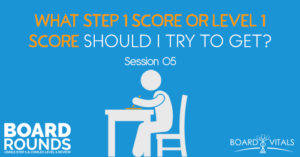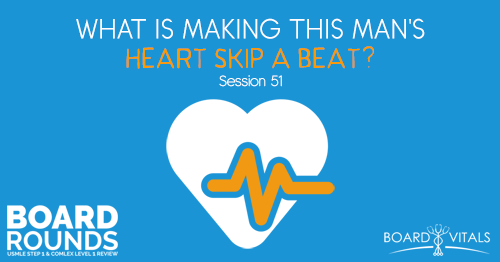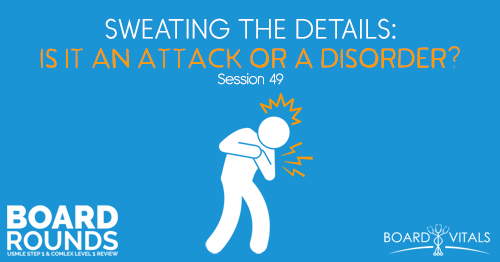Apple Podcasts | Google Podcasts

Session 05
USMLE Step 1 and COMLEX Level 1 scores can play a major role in the specialty that you match in to. Let’s talk about the score that you want to shoot for!
We’re joined as always by Dr. Andrea Paul from Board Vitals, a testing platform to help you prepare for every step of your journey as a medical student, whether it’s Step 1, Level 1, Step 2, Step 3, or all of the Shelf Exams that you have to take as a medical student, and beyond that once you’re out in practice. They offer QBanks and everything they have to offer you, you’re sure to be prepared for your test when it comes to test day. Save 15% when using the promo code BOARDROUNDS.
What Is a Good Step 1 Score?
The definition of a good Step 1 score varies by medical specialty. In orthopedic surgery, applicants successfully match with an average Step 1 score of 248. In family medicine, a good Step 1 score is around 220 (again, based on the average of successful applicants).
[02:12] The Full Answer: What Scores to Shoot For
Andrea says that USMLE has a secret recipe that they score with but they don’t disclose it but the scores range from 1 to 300. (But they won’t officially say that.) Most people score between 140 and 260. The average in 2018 was 229 with a standard deviation of 20. So you’re looking at a 209 to 249, which is incredibly high. Andrea thinks the reason for the increase in average is that people recognize competition and the high stakes of this test.
'People recognize the high stakes of this test more than ever before. We haven't been expanding numbers of residency programs but we have expanded in the number of applicants.'Click To Tweet[05:40] Average Step 1 Scores for Different Specialties
The landscape of competitiveness of different areas has changed for some of the specialties. Anesthesia used to be one of the most competitive. But this changes over time for a lot of reasons. But specialties that have stayed on the top of the list include Dermatology, Orthopedic Surgery, Oncology, ENT, and Neurosurgery.
For 2018, the average USMLE score for people who matched in Orthopedic Surgery was 248. Dermatology is not too far off with 249 and ENT was 248, Neurosurgery at 245. Even the least competitive specialties had quite high average scores. Family medicine was 220, the highest it’s been. Scores are just continuing to increase.
'It's just the sheer number of people competing for these few spots that really require people to study harder and score higher.' Click To Tweet[08:07] Beyond Your Scores
Of course, if you want to get in Dermatology, for instance, then you’ve got to be aiming for something over that 249. That said, other things still matter like the geographic area you’re looking at, your experience, letters of recommendation, etc. Hence, the variation of scores and no specific cutoffs. So even if you’re not in the range, it’s good to still apply.
'It's good to still apply even if you're not in the range. It does not hurt to still try.'Click To TweetThe Step 1 score gets you in the door for a lot of these areas. But after that, they’re not going to pick a 249 over 248 just based on the score. That being said, it’s good to aim high.
[11:29] Breakdown of COMLEX Scores
The scores fall the same way as USMLE does with Dermatology as the highest and Family Medicine as the lowest. Their average score for match candidates was 566 in 2018. For some of the high scoring specialties, Radiology was around 615 while Family Medicine was at 520.
[12:20] Data for Osteopathic Students
There’s anecdotal data that osteopathic students in some geographic areas in some specific institutions have a disadvantage but there’s no specific data. If you’re an osteopathic student and you want to apply to a more traditional MD institution, you may want to consider as this could help in the institution’s diversity. But try to make sure your scores are not only competitive but trying to shine so much that they can’t ignore your application. There could also be a lack of information in some geographic areas on what background DOs come in with. Andrea believes that as this merger happens, this may start to change.
'Make sure your scores are not only competitive but trying to shine so much that they can't ignore your application.'Click To TweetMoreover, if you don’t see a DO in a match list, then don’t let that be a self-perpetuating prophecy. Reach out to the program and tell them you’re an osteopathic student and you want to come to their program due to xyz. Ask them what you should be doing to make yourself competitive and see what they have to say.
[16:35] The Next Steps After Having a Fail Grade
The pass rates are quite high. USMLE last year was at 94% and COMLEX was at 96%. If you haven’t taken the test yet, don’t panic. That being said, the biggest mistake people do is they hide and don’t want to talk to anyone or tell their school about it to the admissions people at the school because they’re embarrassed due to the stigma around. But there’s so much help. So get all the help you need to be successful. You’d be surprised at a network of people you can have once you open up. A lot of schools have these remediation programs too that are willing to pay for additional prep materials in some cases.
'Every school has incredible resources for people who didn't pass. And you'd be surprised once you open up about it.'Click To TweetMoreover, you may want to also change how you study if you feel that your studying strategy was completely ineffective. Or there could be minor tweaks you can do. But this shouldn’t be looked at as something negative or a hopeless situation. If anything, you have the advantage to get a high score on your next attempt.
[20:30] What If You’re Not Ready to Take the Test?
Every school is different. Some may require you to not take clinical rotations until you passed Step 1. While others have different rules and guidelines on that. But Board Vitals has worked with students where they took half a year and joined the clinical rotations a few months later so they could retake their Step 1. Again, talk about this to your school as they could help you make accommodations or give you time or whatever else you might need.
[22:40] Data for Nontraditional Students
There are a couple of studies showing that nontraditional students tend to score lower on both their grades in school and on their USMLE or COMLEX exams. There’s no clear reason as to why that is, however. If you’re a nontraditional student, it’s a good place to look at the various reasons that have been considered such as family commitments.
'Look into your family or whatever support systems you have to make sure that you can really maximize that study time and do the best you can.'Click To TweetRecognize some amount of time where you might have to shift your focus. Try to look back and think about why or look at what traditional students are doing differently, how much time they’re spending or how they’re studying. It could be a technology gap or lack of using online resources.
[25:55] Other Data Available Based on Gender
There’s data showing that males score higher on the USMLE and COMLEX. This is an interesting data point they’ve seen come across many times. As to why there could be so many factors involved such as pay gaps and gender differences that still exist.
[27:00] General Tips
As with anything else, self-care is important. Taking a little pressure off is the best thing people can do. So much pressure can build up over the years from undergrad to MCAT, the med school admissions process and so on. And if you don’t let that ease a little bit once in a while, you’d just end up extremely unhappy and burned out. Identify what makes you feel better and feel better.
[28:30] Board Vitals
Check out Board Vitals for their QBanks for Step 1 or Level 1. If you’re further on in your journey, check out their Shelf Exam materials as well. Use the promo code BOARDROUNDS and get 15% off.
Links:
Board Vitals (Save 15% when using the promo code BOARDROUNDS.)
SEARCH SITE
LISTEN FOR FREE











